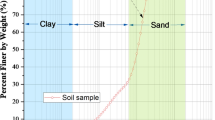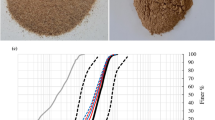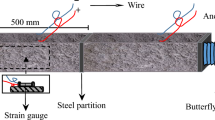Abstract
This paper reports the influence of activator type and concentration on the rheological properties of alkali-activated fly ash suspensions. A thorough investigation of the rheological influences (yield stress and plastic viscosity) of several activator parameters, including: (i) the cation type and concentration of alkali hydroxide and (ii) the alkali-to-binder ratio (n) and silica modulus (Ms), and (iii) the volume of the activation solution, on the suspension rheology is presented. The results indicate a strong dependence on the cation and its concentration in the activation solution. The viscosity of the activation solution and the volumetric solution-to-powder ratio are shown to most strongly influence the plastic viscosity of the suspension. The suspension yield stress is predominantly influenced by the changes in fly ash particle surface charge and the ionic species in the activator. A shift from non-Newtonian to Newtonian flow behavior is noted in the case of silicate-based suspensions for Ms ≤ 1.5. This behavior, which is not observed at higher MS values, or when the fly ash is dispersed in hydroxide solutions or pure water, is hypothesized to be caused by colloidal siliceous species present in this system, or surface charge effects on the fly ash particles. Comparisons of the rheological response of alkali-activated suspensions to that of portland cement-water suspensions are also reported.












Similar content being viewed by others
Abbreviations
- n:
-
Ratio of Na2O in the activator to the total fly ash content
- Ms :
-
Ratio of SiO2-to-Na2O in the activator
- (as/p)v :
-
Activation solution-to-powder ratio, by volume (Refer to the definition of activation solution in 2.1
- (as/b)v :
-
Activation solution-to-binder ratio, by volume; binder implying fly ash here
- (w/s)m :
-
Water-to-solids ratio, mass-based (Refer to the definition of solids in 2.1)
- w/c:
-
Water-to-cement ratio, mass-based, for OPC systems
- τ:
-
Shear stress, Pa
- τy :
-
Yield stress, Pa
- ηp :
-
Plastic viscosity, Pa.s
- ηa :
-
Apparent viscosity, Pa.s
- \( \dot{\gamma} \) :
-
Shear rate, s−1
References
ASTM C109-13 (2013) Standard Test Method for Compressive Strength of Hydraulic Cement Mortars Using 2-in. Cube Specimens.
ASTM C1738 - 11a (2011) Standard Practice for High-Shear Mixing of Hydraulic Cement Paste.
Atzeni C, Massidda L, Sanna U (1985) Comparison between rheological models for portland cement pastes. Cem Concr Res 15:511–519
Banfill PFG (2006) Rheology of fresh cement and concrete. Rheol Rev 2006:61
Barnes HA (1989) Shear-thickening (“dilatancy”) in suspensions of nonaggregating solid particles dispersed in Newtonian liquids. J Rheol 33:329
Barnes HA (1999) The yield stress—a review or “παντα ρει”—everything flows? J Non-Newtonian Fluid Mech 81:133–178
Barnes HA, Non-Newtonian I of, Mechanics F (2000) A handbook of elementary rheology. Univ. of Wales, Institute of Non-Newtonian Fluid Mechanics
Bentz DP, Ferraris CF, Galler MA, Hansen AS, Guynn, JM (2012) Influence of particle size distributions on yield stress and viscosity of cement–fly ash pastes. Cem Concr Res 42:404–409
Bernal SA, Mejía de Gutiérrez R, Provis JL (2012) Engineering and durability properties of concretes based on alkali-activated granulated blast furnace slag/metakaolin blends. Constr Build Mater 33:99–108
Bijen J (1996) Benefits of slag and fly ash. Constr Build Mater 10:309–314
Bingham EC (1922) Fluidity and plasticity
Brady JF (1993) The rheological behavior of concentrated colloidal dispersions. J Chem Phys 99:567–581
Burgos-Montes O, Palacios M, Rivilla P, Puertas F (2012) Compatibility between superplasticizer admixtures and cements with mineral additions. Constr Build Mater 31:300–309
Callaghan PT (2008) Rheo NMR and shear banding. Rheol Acta 47:243–255
Cheng DC-H (1986) Yield stress: a time-dependent property and how to measure it. Rheol Acta 25:542–554
Criado M, Palomo A, Fernández-Jiménez A, Banfill PFG (2009) Alkali activated fly ash: effect of admixtures on paste rheology. Rheol Acta 48:447–455
Cyr M, Legrand C, Mouret M (2000) Study of the shear thickening effect of superplasticizers on the rheological behaviour of cement pastes containing or not mineral additives. Cem Concr Res 30:1477–1483
Davidovits J (1999) Chemistry of geopolymeric systems, terminology. Proceedings of Geopolymer 99:9–40
Davidovits J (2005) Geopolymer chemistry and sustainable development. The poly (sialate) terminology: a very useful and simple model for the promotion and understanding of green-chemistry. Proc 2005 Geopolymer Conf. pp 9–15
Fernández-Jiménez A, Garcia-Lodeiro I, Palomo A (2007) Durability of alkali-activated fly ash cementitious materials. J Mater Sci 42:3055–3065
Ferraris CF (1999) Measurement of the rheological properties of high performance concrete: State of the art report. J Res Natl Inst Stand Technol 104:461–478
Franks GV (2002) Zeta potentials and yield stresses of silica suspensions in concentrated monovalent electrolytes: Isoelectric point shift and additional attraction. J Colloid Interface Sci 249:44–51
Iler RK (1979) The chemistry of silica: solubility, polymerization, colloid and surface properties, and biochemistry
Jeffrey DJ, Acrivos A (1976) The rheological properties of suspensions of rigid particles. AIChE J 22:417–432
Kamal MR, Mutel A (1985) Rheological properties of suspensions in Newtonian and Non-Newtonian fluids. J Polym Eng 5:293–382
Krieger IM, Dougherty TJ (1959) A mechanism for non-Newtonian flow in suspensions of rigid spheres. Trans Soc Rheol 3:137–152
Lootens D, Hébraud P, Lécolier E, Van Damme H (2004) Gelation, shear-thinning and shear-thickening in cement slurries. Oil Gas Sci Technol 59:31–40
Lowke D (2009) Interparticle Forces and Rheology of Cement Based Suspensions. Nanotechnol. Constr. 3. Springer, pp 295–301
Mannheimer RJ (1983) Effect Of Slip On The Flow Properties Of Cement Slurries. Annu Meet Pap Div Prod
Mikanovic N, Jolicoeur C (2008) Influence of superplasticizers on the rheology and stability of limestone and cement pastes. Cem Concr Res 38:907–919
Mueller S, Llewellin EW, Mader HM (2010) The rheology of suspensions of solid particles. Proc R Soc Math Phys Eng Sci 466:1201–1228
Nägele E (1986) The zeta-potential of cement: Part II: Effect of pH-value. Cem Concr Res 16:853–863
Nägele E, Schneider U (1989) The zeta-potential of blast furnace slag and fly ash. Cem Concr Res 19:811–820
Nehdi M, Rahman M-A (2004) Effect of geometry and surface friction of test accessory on oscillatory rheological properties of cement pastes. ACI Mater J 101:
Palacios M, Houst YF, Bowen P, Puertas F (2009) Adsorption of superplasticizer admixtures on alkali-activated slag pastes. Cem Concr Res 39:670–677
Palomo A, Grutzeck MW, Blanco MT (1999) Alkali-activated fly ashes: a cement for the future. Cem Concr Res 29:1323–1329
Papo A, Piani L (2004) Effect of various superplasticizers on the rheological properties of Portland cement pastes. Cem Concr Res 34:2097–2101
Pasquino R, Nicodemi F, Vanzanella V et al (2013) A rheological phase diagram of additives for cement formulations. Rheol Acta 52:395–401
Poulesquen A, Frizon F, Lambertin D (2013) Rheological behavior of alkali-activated metakaolin during geopolymerization. Cem.-Based Mater Nucl Waste Storage. Springer, pp 225–238
Provis JL, Van Deventer JSJ (2009) Geopolymers: Structure, processing, properties and industrial applications. Woodhead Cambridge, UK
Provis JL, Muntingh Y, Lloyd RR et al (2007) Will Geopolymers Stand the Test of Time? Dev Porous Biol Geopolymer Ceram Ceram Eng Sci Proc 235
Puertas F, Fernández-Jiménez A (2003) Mineralogical and microstructural characterisation of alkali-activated fly ash/slag pastes. Cem Concr Compos 25:287–292
Qing-Hua C, Sarkar SL (1994) A study of rheological and mechanical properties of mixed alkali activated slag pastes. Adv Cem Based Mater 1:178–184
Ravikumar D, Neithalath N (2012) Reaction kinetics in sodium silicate powder and liquid activated slag binders evaluated using isothermal calorimetry. Thermochim. Acta
Ravikumar D, Neithalath N (2012b) Effects of activator characteristics on the reaction product formation in slag binders activated using alkali silicate powder and NaOH. Cem Concr Compos 34:809–818
Saak AW, Jennings HM, Shah SP (2001) The influence of wall slip on yield stress and viscoelastic measurements of cement paste. Cem Concr Res 31:205–212
Santamarı´a-Holek I, Mendoza CI (2010) The rheology of concentrated suspensions of arbitrarily-shaped particles. J Colloid Interface Sci 346:118–126
Scales PJ, Johnson SB, Healy TW, Kapur PC (1998) Shear yield stress of partially flocculated colloidal suspensions. AIChE J 44:538–544
Schall P, van Hecke M (2009) Shear bands in matter with granularity. Annu Rev Fluid Mech 42:67
Škvára F, Kopecký L, Šmilauer V, Bittnar Z (2009) Material and structural characterization of alkali activated low-calcium brown coal fly ash. J Hazard Mater 168:711–720
Stebbins JF, Farnan I, Xue X (1992) The structure and dynamics of alkali silicate liquids: a view from NMR spectroscopy. Chem Geol 96:371–385
Svensson IL, Sjöberg S, Öhman L-O (1986) Polysilicate equilibria in concentrated sodium silicate solutions. J Chem Soc Faraday Trans 1(82):3635–3646
Sweeny KH, Geckler RD (1954) The rheology of suspensions. J Appl Phys 25:1135–1144
Termkhajornkit P, Nawa T (2004) The fluidity of fly ash-cement paste containing naphthalene sulfonate superplasticizer. Cem Concr Res 34:1017–1024
Tognonvi MT, Massiot D, Lecomte A et al (2010) Identification of solvated species present in concentrated and dilute sodium silicate solutions by combined 29Si NMR and SAXS studies. J Colloid Interface Sci 352:309–315
Vance, Kirk (2014) Early Age Characterization and Microstructural Features of Sustainable Binder Systems for Concrete. PhD Dissertation, Arizona State University
Vance K, Kumar A, Sant G, Neithalath N (2013) The rheological properties of ternary binders containing Portland cement, limestone, and metakaolin or fly ash. Cem Concr Res 52:196–207
Wijnen P, Beelen TPM, De Haan JW et al (1989) Silica gel dissolution in aqueous alkali metal hydroxides studied by 29Si NMR. J Non-Cryst Solids 109:85–94
Acknowledgments
The authors gratefully acknowledge the National Science Foundation (CMMI 1068985) and Arizona State University for the partial support of this research. The materials for this research were provided by Headwaters Resources and PQ Corporation, and are acknowledged. K.V. also acknowledges the Dean’s Fellowship from the Ira A. Fulton Schools of Engineering at Arizona State University (ASU). This research was conducted in the Laboratory for the Science of Sustainable Infrastructural Materials (LS-SIM) at ASU and the authors gratefully acknowledge the support that has made this laboratory possible. The contents of this paper reflect the views of the authors who are responsible for the facts and accuracy of the data presented herein, and do not necessarily reflect the views and policies of the funding agency, nor do the contents constitute a standard, specification, or a regulation.
Author information
Authors and Affiliations
Corresponding author
Rights and permissions
About this article
Cite this article
Vance, K., Dakhane, A., Sant, G. et al. Observations on the rheological response of alkali activated fly ash suspensions: the role of activator type and concentration. Rheol Acta 53, 843–855 (2014). https://doi.org/10.1007/s00397-014-0793-z
Received:
Revised:
Accepted:
Published:
Issue Date:
DOI: https://doi.org/10.1007/s00397-014-0793-z




